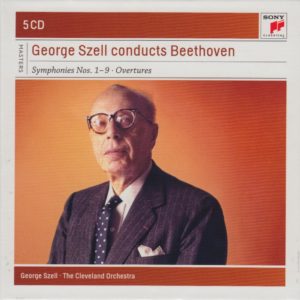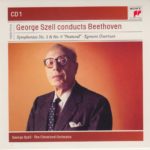 This morning’s performance of Beethoven’s Symphony No. 1 will introduce me to conductor George Szell (1897-1970) and The Cleveland Orchestra, which means today’s recording is the first I’m hearing by an American orchestra.
This morning’s performance of Beethoven’s Symphony No. 1 will introduce me to conductor George Szell (1897-1970) and The Cleveland Orchestra, which means today’s recording is the first I’m hearing by an American orchestra.
Frankly, I didn’t know Cleveland even had an orchestra, let alone a great one. Yet, according to its bio on Wikipedia:
The Cleveland Orchestra, based in Cleveland, is one of the five American orchestras informally referred to as the “Big Five”. Founded in 1918 by the pianist and impresario Adella Prentiss Hughes, the orchestra plays most of its concerts at Severance Hall. As of 2017, the incumbent music director is Franz Welser-Möst.
In 2012 Gramophone Magazine ranked the Cleveland Orchestra number 7 on its list of the world’s greatest orchestras, and The New York Times referred to the orchestra in 2018 as “America’s most understatedly amazing orchestra.”
The orchestra was founded in 1918 by Adella Prentiss Hughes, with Nikolai Sokoloff as its principal conductor. From early in its existence, it toured throughout the eastern United States, made radio broadcasts, and recorded many albums. Subsequent principal conductors, with the title of Music Director, were Artur Rodziński (1933–1943), Erich Leinsdorf (1943–1944), and George Szell (1946–1970).
From 1964 to 1965, James Levine served as an apprentice to Szell with the Cleveland Orchestra, and then served as its assistant conductor until 1970.
Subsequent Music Directors were Pierre Boulez (Musical Advisor 1970-1972), Lorin Maazel (1972–1982), and Christoph von Dohnányi (1984–2002). Franz Welser-Möst has been Music Director since 2002 and is contracted to remain through the 2021-2022 season.
Szell’s long reign as Music Director has been largely credited for the orchestra’s rise to eminence. He reformed the orchestra in the late-1940s, firing a dozen musicians in the process with a dozen more leaving of their own volition.[8] Szell is also credited with giving the orchestra its distinct, European sound.[8] He pushed an ambitious recording schedule with the orchestra, bringing its music to millions worldwide. Szell’s influence has continued, even decades after his death.
Cleveland is the smallest city amongst the traditional “Big Five” orchestras; the others are based in Boston, New York, Philadelphia, and Chicago. However, musicians in Cleveland are often treated as local celebrities, and, much like sports heroes elsewhere, fans seek autographs after performances and greet musicians on the street. Clevelanders are proud that their city boasts an orchestra that has several times been touted as America’s finest, and compared favorably to many of the great orchestras in Central Europe. In the 1960s fans were known to “have airport rallies when the orchestra comes home from tour [and] chant, ‘We’re the best! We’re the best!’ and carry placards reading ‘Bravo!'”
Hmmm. Where have I been all this time? I knew about the other American orchestras listed, especailly Boston, New York, and Chicago. I had no idea Cleveland was considered a “Big Five” orchestra in the United States.
George Szell and The Cleveland Orchestra are likely to be forever intertwined. According to his bio on Wikipedia:
George Szell (June 7, 1897 – July 30, 1970), was a Hungarian-born Jewish-American conductor and composer. He is widely considered one of the twentieth century’s greatest conductors. He is remembered today for his long and successful tenure as music director of the Cleveland Orchestra of Cleveland, Ohio, and for the recordings of the standard classical repertoire he made in Cleveland and with other orchestras.
Szell came to Cleveland in 1946 to take over a respected if undersized orchestra, which was struggling to recover from the disruptions of World War II. By the time of his death he was credited, to quote the critic Donal Henahan, with having built it into “what many critics regarded as the world’s keenest symphonic instrument.” Through his recordings, Szell has remained a presence in the classical music world long after his death, and his name remains synonymous with that of the Cleveland Orchestra. While on tour with the Orchestra in the late 1980s, then-Music Director Christoph von Dohnányi remarked, “We give a great concert, and George Szell gets a great review.”
 Beethoven wrote his symphonies in four parts (except for the Sixth, which is in five). The time breakdown of this one (Symphony No. 1 in C Major), from this particular conductor (Szell, at age 67) and this particular orchestra (The Cleveland Orchestra), at this particular time in history (October 2, 1964) on this particular record label (Sony Classical) is as follows:
Beethoven wrote his symphonies in four parts (except for the Sixth, which is in five). The time breakdown of this one (Symphony No. 1 in C Major), from this particular conductor (Szell, at age 67) and this particular orchestra (The Cleveland Orchestra), at this particular time in history (October 2, 1964) on this particular record label (Sony Classical) is as follows:
I. Adagio molto………………………………………………………………………………..9:19
II. Andante cantabile con moto………………………………………………………6:57
III. Menuetto. Allegro molto e vivace………………………………………………3:49
IV. Adagio – Allegro molto e vivace…………………………………………………5:49
Total running time: 25:14
My Rating:
Recording quality: 4 (slight tape hiss, not uncommon for its age, and some ambient sounds)
Overall musicianship: 4
CD liner notes: 0 (none; boo! hiss!)
How does this make me feel: 3
I don’t have an opinion about this performance one way or another. I seems competent. Probably technically accurate. Maybe even expertly conducted.
Yet, it doesn’t move me. It remains competent.
And the lack of liner notes (a personal bugaboo of mine) doesn’t sweeten the deal. If this competent performance would have included a blockbuster booklet of liner notes, maybe I’d have gotten more excited about this performance. Alas.
There are eight more Beethoven symphonies awaiting me in this slim box set from George Szell and The Cleveland Orchestra. Perhaps the others are more electrifying.
Meh.
